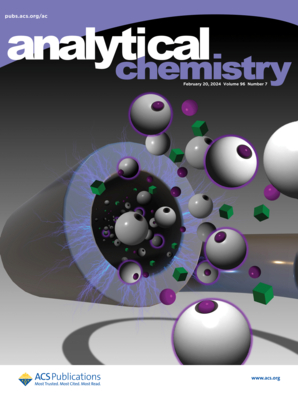由 pH 值驱动的高稳定性水凝胶磁松弛开关传感器用于灵敏检测 Cd2+
IF 6.7
1区 化学
Q1 CHEMISTRY, ANALYTICAL
引用次数: 0
摘要
传统的磁弛豫开关(MRS)传感器灵敏度高,但稳定性差,因为磁弛豫信号容易受到外部磁场或环境氧化的影响。本研究建立了一种高稳定性的基于水凝胶珠的磁弛豫开关(Gel-MRS)传感器,用于准确灵敏地检测水稻中的 Cd2+。该传感器以 pH 响应水凝胶珠为核心元件,用于目标刺激和横向弛豫信号传导。稳定性实验表明,在外加磁场下,Gel-MRS 传感器的横向弛豫时间(T2)变化是传统磁性纳米粒子的七分之一,小于空气中 Fe2+/Fe3+ 转换时间的五分之一。Gel-MRS 传感器之所以具有出色的稳定性,是因为其 T2 来自于 pH 值介导的溶胀系统,而不是传统的磁性纳米粒子的聚集/分散或 Fe2+/Fe3+ 转换。此外,目标 Cd2+ 可专门触发水凝胶珠的 pH 响应,改变 T2,从而使 Gel-MRS 传感器具有出色的弛豫特性(R2 = 56.89)和 pH 响应性。水凝胶珠的溶胀过程遵循准二阶动力学。Gel-MRS 传感器对 Cd2+ 的检测限低至 0.009 ng/mL,线性范围为 0.01-5 ng/mL。出色的稳定性和灵敏度使 Gel-MRS 传感器在食品和环境检测方面具有巨大的应用潜力。本文章由计算机程序翻译,如有差异,请以英文原文为准。

High Stability Hydrogel Magnetic Relaxation Switch Sensor Driven by pH for the Sensitive Detection of Cd2+
The traditional magnetic relaxation switching (MRS) sensors have excellent sensitivity, but their stability is poor because the magnetic relaxation signal is easily affected by the external magnetic field or environmental oxidation. In this study, a highly stable hydrogel bead-based MRS (Gel-MRS) sensor was established for the accurate and sensitive detection of Cd2+ in rice. A pH-responsive hydrogel bead was applied as a core element for the target stimulus and transverse relaxation signal transduction. The stability experiments showed that the transverse relaxation time (T2) change of the Gel-MRS sensor was one-seventh that of traditional magnetic nanoparticles under an external magnetic field and less than a fifth that of Fe2+/Fe3+ conversion in air. The excellent stability was due to the fact that T2 of the Gel-MRS sensor came from the swelling system mediated by pH rather than the traditional aggregation/dispersion or Fe2+/Fe3+ conversion of magnetic nanoparticles. In addition, the target Cd2+ could exclusively trigger a pH response of the hydrogel beads, altering the T2, thus resulting in excellent relaxation properties (R2 = 56.89) and pH responsiveness of the Gel-MRS sensor. The swelling process of the hydrogel beads followed quasi-second-order dynamics. The Gel-MRS sensor demonstrated a remarkable limit of detection as low as 0.009 ng/mL for Cd2+, with a linear range of 0.01–5 ng/mL. The excellent stability and sensitivity made the Gel-MRS sensor have great application potential in food and environmental detection.
求助全文
通过发布文献求助,成功后即可免费获取论文全文。
去求助
来源期刊

Analytical Chemistry
化学-分析化学
CiteScore
12.10
自引率
12.20%
发文量
1949
审稿时长
1.4 months
期刊介绍:
Analytical Chemistry, a peer-reviewed research journal, focuses on disseminating new and original knowledge across all branches of analytical chemistry. Fundamental articles may explore general principles of chemical measurement science and need not directly address existing or potential analytical methodology. They can be entirely theoretical or report experimental results. Contributions may cover various phases of analytical operations, including sampling, bioanalysis, electrochemistry, mass spectrometry, microscale and nanoscale systems, environmental analysis, separations, spectroscopy, chemical reactions and selectivity, instrumentation, imaging, surface analysis, and data processing. Papers discussing known analytical methods should present a significant, original application of the method, a notable improvement, or results on an important analyte.
 求助内容:
求助内容: 应助结果提醒方式:
应助结果提醒方式:


